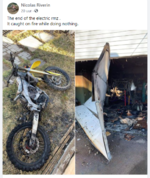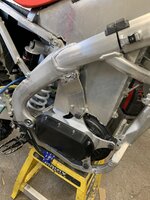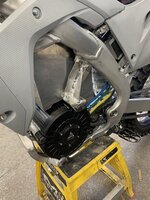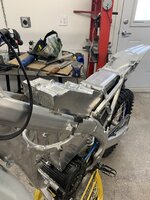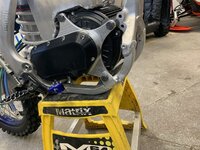The Alta pack uses a passive system with the thermal plate (and some imbedded heat pipes) sandwiched between two modules. The thermal "plate" is very thin (about .050) and given the same thickness to the pack housing (radiating surface) simply can't move enough heat when the going gets tough. Everyone's probably seen pictures and understand this. The other limiting factor is that only the negative end is thermally connected to the plate using electrically isolating thermal conductive film adhesive. Now, studies have shown that the negative end IS the best place to pull heat out due the "jellyroll" design making heat much easier to move in the axis of the cylinder. That why Alta kinda invented the one-sided cell electrical connection, but it's also reason for some of the reliability issues. Heat moving radially is resisted by all the layers of insulation between electrodes. Tesla uses radial cooling (core to sides), but they cool the water first (using the onboard AC) making for a much higher delta T which and along with the increased surface area, more that makes up for the poor thermal path. Here's the rub, even the negative end ultimately (thermal wise) chokes down to the width and thickness of the final "pigtail" on the negative electrode which is only spot welded to the end of the cell. That's one reason cells of virtually identical specs can vary so much in max continuous discharge rates. For "negative end" cooling (like the Varg), cells using 100% of the negative electrode in thermal contact with the cylinder end offer the best possible thermal path. Not sure if the Varg uses these or not, they're very expensive and hard to get. Then you need to make sure you don't waste all this thermal efficiency by using a TIM (thermal interface material) from cell end to your thermal plate with the highest conduction rates while still being electrically isolating, a tough ask as the materials tend to be opposite in nature. You could isolate P groups and bond conductively only and/or mechanically connect only to "islands" of thermal plates and therefore not worry about shorting, but manufacturing wise it would make the pack very expensive and it's not practical. Any external electrical path (a screwdriver) between isolated islands and "poof". Finally, you need to make sure your plate/housing/whatever, can dissipate the required heat ultimately using ambient temperature (air temp) as the thermal conductor. Air is a crummy conductor, particularly when you consider that there's not much delta T between air, at say 80F, and the max cell temperature (assuming no active system like Tesla where pre-cooling can be done). I personally question Vargs cooling plates, they don't have much fin area and that's what counts. I have no idea what TIM they use.Hey mark may I ask you what type of thermal interface you used to connect the cells to the cold plate? Or at least what the original alta pack used?
Now, my experimental Alta pack was modified by enlarging the electrical wire mouse holes in the thermal plates. This allowed fluid to flow between modules. This was tricky as too much could compromise durability of the cases. Getting the fluid flow to "circulate" properly took some work. Large AN fittings were attached to a custom made lower cover and upper cover. The lower cover was needed to keep volume as low as possible and direct fluid intimately over the bottom module. The system directed the fluid in a "bottom to top" direction. The stock module safety covers were removed in this experiment. Fluid would enter from the lower cover front and naturally flow to the rear where low pressure and the enlarged mouseholes were. Fluid would then continue to the second module (counting bot to top). In the center (between case halves and mod 2 and 3) I added a thin plate (non-conductive) slightly open at the front which helped keep the flow intimate to the cell tops of the 2nd mod and redirected flow over module three. It would then repeat the process going up through the upper case mouseholes and wash over the forth module as it exited the front of the top cover. The BMS cover assured intimate contact with the top module cells. Obviously, a pump and typical fluid to air radiators were used.
Here's the qualifier. The Alta cell "honeycomb" didn't allow any flow between cells, it's just that way. So, the idea was to remove heat from the positive ends of the cells just like the negative ends. Typically, this is prevented due to the interconnects, but with fluids these constraints don't occur. I haven't seen any studies about the efficiency of positive end thermal conduction, so I was kinda flying by the seat of my pants. Like I said before, I dropped the concept due to the hassle of buying and using DI fluids and lackluster results. But I'm not saying that with much more research it couldn't be a viable solution. At least until better cells are made commercially available. My bet is with the cells, and that's many years away, Lol.
The pack I built for my KTM supermini 85 was designed to cool both cell ends using water. The cells themselves never see the water, so no short worries. The double sided cooling is something I invented but probably wouldn't do it again. The tolerances of the cold plates and virtually every aspect of that build had to be way too tight, like +/-.005. While not a big deal for a CNC machine, at the final assembly level things wern't so simple.

